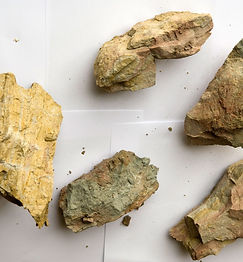

The greatest lands in the world only give of their best
If their soil are Alive !
For Claude Bourguignon, agronomist in soil microbiology, ‘Red wines are as strong and complex as the internal clay surfaces supporting them are of high density’ What is the internal surface of clay? Clay is composed of layered sheets. Side by side, these sheets represent the surface of clay. The internal surface is the sum of the surface of these layers for 1 gram of clay. The higher the internal surface area, the higher the quality and complexity of the clay. The quality of the clay is measured by square meter of the internal surface per gram of clay.
Our soils are very clay rich. They are mostly composed of:
-
Garrigue or plane soil which is ‘Mindel’ clayey limestone on the surface containing ‘ICTITES’ clay.
-
'Pliocene’ clayey blue marl containing ‘SMECTITES’ clay.
-
‘Helvetian’ sand and sandstone containing ‘Montmorillonite’ clay
This is a soil which is found in the Chateauneuf du Pape, Gigondas and Vacqueyras classifications.
A Geology which Enables Great Wines
The Soils



Garrigues Soil
Most of our domain is made up of Garrigues Soil: Soil plus round stones for one or two meters depth (photos). This is old ‘Mindel’ alluvium (formation of clay and limestone). The internal surface of this clay is between 200 and 250 m2 per gram. The sombre colour and presence of stones retains the heat which promoting the maturing of the grapes.


Blue Marl Clay
Under the Garrigues soil (brown zone) are the Pliocene blue marl clay (grey/blue zone). The internal surface is about 300 m2 per gram. Here you can see a large close up of a sample of blue marl clay.
Sand and Sandstone (Montmorillonite)
The Helvetian sand and sandstone are found generally under the blue marl clay. This layer is characterised by an internal surface area of 600 m2 per gram, called ‘Montmorillonite’. It is the best clay in which to produce quality red wine.

